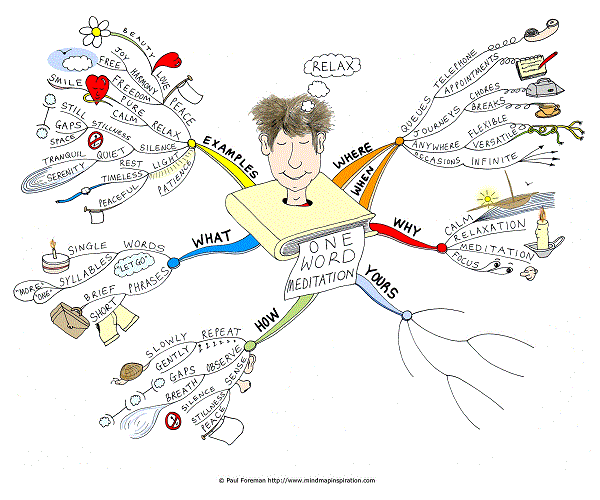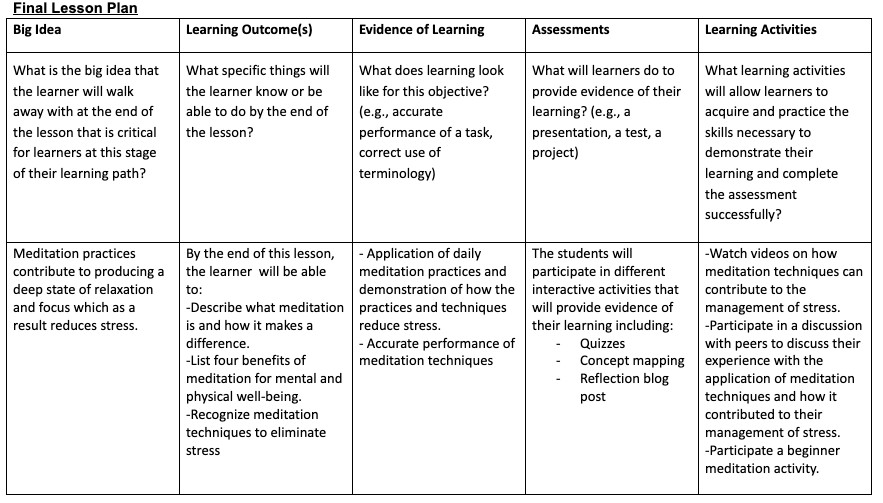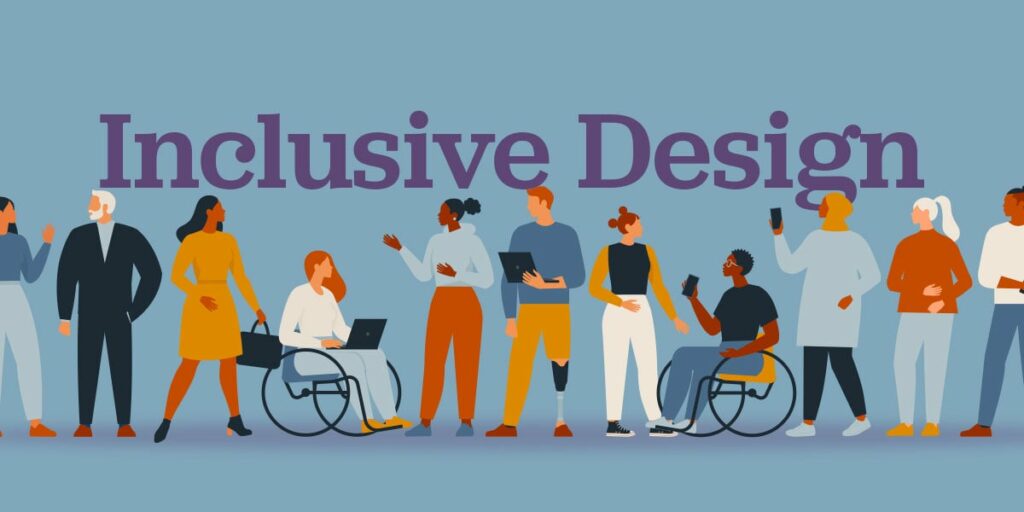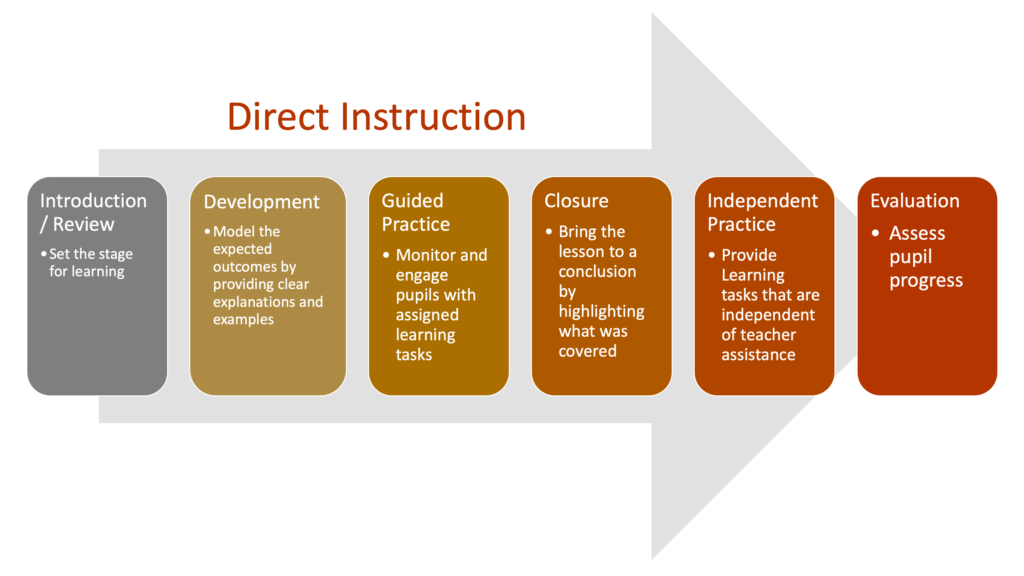Category: EDCI 335
Stress Management through the Use of Meditation
2022-12-04 / MS25 / 0 COMMENTS

EDCI 337: Multimedia Design Project
Maximo Savellano, Abdullahi Bashir, & Akira Onishi
Overview
The final weeks of school can be extremely stressful. Upcoming finals and final assignments can lead to elevated levels of stress and can ultimately hinder performance.
So this This week, we will be learning about Mediation and it’s benefits and how we can use it to manage stress and anxiety.
To help us understand the concept of Meditation – lets begin with an introductory video on what exactly Meditation is.
Let’s begin!
Lesson Objectives
By the end of this blog you will be able to:
- Describe what meditation is and how it makes a difference.
- List up to four benefits of meditation for mental and physical well-being.
- Recognize meditation techniques that reduce or eliminate stress.
Read/Watch
Watch: The Scientific Power of Meditation (2:59 minutes) – Let’s dive into the scientific perspective of meditation.
Read: Meditation for Stress – Read on what causes stress and how we can use meditation to mitigate stress.
Read: 28 Meditation Statistics: How Many People Meditate? – Read on some statistics of Meditation
Content – Let’s Learn!
Let’s now learn different meditation techniques, how meditation makes a difference and benefits of meditation!
Meditation: A simple, fast way to reduce stress
Since ancient times, meditation has been used to increase knowledge of the mystical and divine energies that govern existence. Nowadays, people commonly employ meditation to de-stress and ease tension (2022, March 30). For the body and mind, meditation is viewed as a type of supplementary therapy. Deep relaxation and mental calmness are the results of meditation. The person concentrates during meditation and gets rid of the constant stream of disorganized ideas that might be causing stress. As an outcome, both physical and emotional well-being is improved. There are several types of meditation. However, most meditation techniques have similar features, including (2022a, April 29):
- A quiet setting
- A comfortable position
- Focused attention
- An open attitude
- Relaxed breathing
Some of the meditation types include guided meditation, mantra meditation and mindfulness meditation (2022b, April 29). Meditation makes a significant difference because it promotes a state of balance, serenity, and tranquillity that is good for one’s mental, emotional, and physical health (2022, May 5).
Different Meditation Techniques
Meditation comes in many different forms and can be practiced through a variety Meditation comes in many different forms and can be practiced through various techniques. Meditation is especially effective as a classroom practice and helps strengthen self-regulation, boost health, and reduce negative feelings/anxiety (Kuranishi, 2018). When implementing meditation, it is essential to begin with, simple techniques to effectively train the mind to keep focus. Before choosing a meditation technique, it is important to learn how to meditate. The following is an effective guide provided by the Mindful organization on how to meditate:
1) Take a seat
Find a place to sit that feels calm and quiet to you.
2) Set a time limit
If you’re just beginning, it can help to choose a short time, such as five or 10 minutes.
3) Notice your body
You can sit in a chair with your feet on the floor, you can sit loosely cross-legged, you can kneel—all are fine. Just make sure you are stable and in a position you can stay in for a while.
4) Feel your breath
Follow the sensation of your breath as it goes in and as it goes out.
5) Notice when your mind has wandered
Inevitably, your attention will leave the breath and wander to other places. When you get around to noticing that your mind has wandered—in a few seconds, a minute, five minutes—simply return your attention to the breath.
6) Be kind to your wandering mind
Don’t judge yourself or obsess over the content of the thoughts you find yourself lost in. Just come back.
7) Close with kindness
When you’re ready, gently lift your gaze (if your eyes are closed, open them). Take a moment and notice any sounds in the environment. Notice how your body feels right now. Notice your thoughts and emotions.
Provided by (Mindful Communications & Such PBC, 2022)
After learning the basics of meditation, we can now observe the different techniques and how they can help reduce stress and anxiety. There are two main kinds of meditation techniques; guided and unguided meditation. In guided meditation, an instructor guides you through meditation and is usually recommended to beginners to get used to meditation. The other is unguided meditation which is the process of meditating alone. While these two are the basic types of meditation, there are specific types with different benefits and purposes. Here are five types of meditation techniques and their purposes.
Mindfulness Meditation
Mindfulness Meditation is the act of being aware of the present moment. This form of meditation can be done at any time and requires complete focus on what is being done in the present moment—for example, brushing your teeth, washing dishes, and running. Mindfulness meditation is effective for beginners as it takes their minds off external stresses and allows them to be present at the moment.
Body scan Meditation
Body Scan meditation focuses on consciously relaxing different parts of the body. This meditation helps relieve muscle tension built up from stress and anxiety. Being consciously aware of body parts can increase mind and body connection.
Walking Meditation
Walking meditation is the process of focusing on each step in order to be fully present. Focusing on the mechanics and motion of each step heightens situational awareness and increases the feeling of being present. This type of meditation is used by individuals who are jittery and find it difficult to stay still.
Loving Kindness Meditation
Loving Kindness meditation is a form of meditation that focuses on self-love and the cultivation of compassion for others. Loving Kindness Meditation helps with body image and empathy, this type of meditation starts with positive intention for oneself.
Transcendental Meditation
This type of meditation focuses on a phrase or mantra through repetition. Transcendental meditation utilizes the phrase/mantra as the object of awareness and allows individuals to focus and be aware of their surroundings. Choosing the mantra/phrase can also be beneficial, as positive mantras help with positive intention.
Benefits of meditation
1- Reduces stress:
Stress disrupts sleep, promotes anxiety and increases blood pressure. An eight-week study called “mindfulness meditation” proved that meditation reduced the inflammation response caused by stress (Thorpe, 2020).
2- Controls anxiety:
According to Dr. Thrope, eight weeks of mindfulness meditation helped reduce anxiety symptoms in people with generalized anxiety disorder, along with increased positive self-statements and improved stress reactivity and coping.
3- Increases attention span:
The Study shows that listening to a meditation tape improved accuracy and attention while completing a task. Similar studies have shown better performance on visual tasks than those without any meditation experiences (Thorpe, 2020).
4- Leads to kindness:
Meditation techniques, such as Loving Kindness Meditation, increase positive feelings. Another study of 50 university students showed that practising Loving Kindness Meditation three times a week improved positive emotions, interpersonal relationships and understanding of others after four weeks (Thorpe, 2020).
Activities
Actvity 1 – Shark Fin Exercise
Now that we have learned about different meditation types, let’s do a beginner meditation exercise so you can begin your meditation journey!

Activity 2 – Concept Map
Create a concept map outlining at least four aspects of your school-related stress and how you were able to handle it?

Quiz
How well do you know your Meditation Statistics?
hint: complete your Readings!about:blank
Reflection
- When you tried practicing meditation techniques provided, Did it make any difference?
- How did you handle school related stress before? have you ever tried practicing meditation to reduce stress? What was the result?
- Are there any other benefits experienced or noticed when used the meditation techniques provided?
- Do you think you will use the meditation practices provided whenever you face stress?
To Do This Week
- Complete the Read/Watch Section
- Complete the Let’s Learn Section
- Complete and participate in the learning activities
- Complete the Meditation Statistics Quiz
- Complete the reflection questions
Theories and Principles
Merrils Principles of Instruction
We utilized the three following principles from Merril’s Principles of Instruction to teach learners about the topic of Meditation:
Demonstration
It is stated in this phase that educators must show vs tell. To effectively introduce the concept of meditation, we utilized the demonstration principle in our content by introducing learners to different videos and demonstrations of meditation. During this phase learners observe how meditation works and how it can be applied in real life.
Application
In the application process, Merrill believed that relying on memory was not sufficient enough for applying learning. Merrill believes that learners should actually do what they learned to understand the content in a real-life aspect. Although we created a multiple choice exam in our lesson, we also implemented interactive activities that allow the learner to perform meditation techniques and recognize the process of meditation.
Integration
Lastly, the integration principle is where learners must transfer their knowledge into practice. We utilized this principle by allowing the learners to reflect on their experiences and gave them opportunities to teach what they learned and most importantly practice what they learned. Our focus on integration was to help the learner create a new habit which will ultimately help them reduce stress and anxiety.
Mayer’s Theory of Multimedia Learning
We used some of Mayer’s principles, such as the Cognitive Load Theory, by structuring our lecture with distinct, bold headers and removing everything that would distract the student. Additionally, the multimedia material that calls for interaction provides explicit instructions for how to use it. The coherence principle, by only adding relevant materials and activities to our topic and avoiding irrelevant information and destructing materials. The signalling principle, by ensuring the key information is displayed clearly with headers and highlighted to make it simple to identify and access.
Other Design Principles
Universal Design for Learning
We have employed some of the UDL theory in creating the lessons. For instance, we have provided multiple means of engagement to increase the effectiveness of learning, we have selected different methods, materials and media to address learners variability. In addition, we set a learning goal to guide students as they work through the course, and to assess their learning progress.
Final Lesson Plan and Final Project Plan


References
Kuranishi. (2018, October 28). Pause, Refocus, Assess: Meditation in the Classroom. edutopia.org. https://www.edutopia.org/blog/pause-refocus-assess-meditation-classroom-adam-kuranishi
Learning Science Made Easy: Merrill’s Principles of Instruction | WBT Systems. (n.d.). https://www.wbtsystems.com/learning-hub/blogs/merrills-principles-of-instruction
Meditation – Mayo Clinic. (2022, May 5). https://www.mayoclinic.org/tests-procedures/meditation/about/pac-20385120
Meditation: A simple, fast way to reduce stress. (2022a, April 29). Mayo Clinic. https://www.mayoclinic.org/tests-procedures/meditation/in-depth/meditation/art-20045858
Meditation: A simple, fast way to reduce stress. (2022b, April 29). Mayo Clinic. https://www.mayoclinic.org/tests-procedures/meditation/in-depth/meditation/art-20045858
Mindful Communications & Such PBC. (2022, February 5). Mindful – healthy mind, healthy life. Mindful. https://www.mindful.org/
Smith, L. (2022, November 11). 28 Meditation Statistics: How Many People Meditate? The Good Body. https://www.thegoodbody.com/meditation-statistics/
Thorpe, M., MD PhD. (2020, October 27). 12 Science-Based Benefits of Meditation. Healthline. https://www.healthline.com/nutrition/12-benefits-of-meditation
Welch, A., & Laube, J., MD. (2022, March 30). Meditation: A Guide on How to Meditate for Stress Reduction and More. EverydayHealth.com. https://www.everydayhealth.com/meditation/

To access the Pod #6 Google Doc: Click here
Overview:
Hello there, Abdullah, Ehtesham, Lai, Samara, and Cy. Thank you for submitting your interactive learning resource draft about “Stress in the Workplace and its Management Techniques.” I truly appreciate the topic you picked since stress management is critical in the workplace. When I was doing the Co-op, work was difficult and stressful sometimes, and it was vital to handle the tension. In the following sections, I will try to provide any feedback that I have following the structure you have created in your draft.
Description and Rationale:
I loved how you explained why it is important to create a learning resource regarding workplace stress management topic. However, correct me if I’m wrong, but I couldn’t locate the description and rationale for the learning theory (whether it’s behaviourism, cognitivism, or constructivism) and the learning design (whether it’s inquiry, project-based, direct teaching, etc) on which your resource will be based. I think It will be useful to provide a learning theory and learning design that will be based on your resource, as well as explain why you choose that theory and design.
Learning Context:
The resource appears to be lacking context on the specific audience being targeted; I couldn’t establish the particular age or demographic it was aimed towards. Perhaps targeting a specialised demographic would be preferable, as the working class is vast and cannot be targeted everyone at once. Knowing your audience helps you decide what information to include, how to arrange that information, and what type of supporting elements are required for the reader to grasp what you are presenting.
Learning Outcome:
I appreciated the important questions you presented. However, I believe it is critical to explicitly explain the Learning Outcomes since the Learning Outcome declarations define what students are supposed to know, accomplish, and value as a result of the learning. They direct the development of instructional techniques, resources, learning activities, and assessments. They also assist students decide what and how to study throughout the course.
Interactive Activities:
The various interactive activities available in the resource are amazing. For example, I loved the thought of employing a concept map activity since it helps students to see the broad picture and visualise interconnections while also developing higher cognitive skills.
Assessment Plan:
Both formative and summative assessment plans given in resource are incredibly useful and impactful as they drive students to focus, learn and improve .I really appreciate you taking the time and effort to design these activities.
Diverse Inclusion:
Correct me if I’m wrong, but I couldn’t identify anything in the recourse regarding your approach for inclusion in the context, such as colour blindness, English language learner (ELL), or hearing loss. I believe it is critical to consider varied inclusion because it benefits both students with learning differences and students who do not have learning differences by making them more aware, tolerant, and understanding of one another.
Technology Choices Rationale:
I’m not sure if you offered any specific technologies that will be employed during this course and the rationale for selecting them, but I believe it will be extremely important to highlight in the resource so that students are aware of it.
Presentation:
Overall, the learning resource looks pretty good considering it to be a draft and not complete. However, I would suggest incorporating different formats and visuals rather than just relying on paragraphs. In addition, I would recommend utilizing online tools such as Notion to present your recourse as it allows you to have numerous formats and add new visuals.
Conclusion
I particularly appreciate the topic you chose as well as the learning resource you developed. You did an excellent job connecting all of the information and developing all of the activities. I believe your learning resource is nearly complete and only requires a few more details to be perfect. Excellent work, and I eagerly await your final version.

The video I’ve selected to view to respond to the questions below is titled “What is Parkinson’s Disease?”
” What kind of interaction would the video require from your students? Does it force them to respond in some way (inherent)?”
In this video, the students are presented with concepts and information regarding Parkinson’s disease(PD) and is used visual graphics with speech to convey the information nicely. Although students are not required to engage directly with the video, they are nevertheless expected to pay attention and understand the material in order to retain and remember the information presented. The students can also check more information regarding the disease in “Parkinson’s 360 multimedia toolkit”.
” In what way are they likely to respond to the video on their own, e.g. make notes, do an activity, think about the topic (learner-generated)?”
It is required the students that they watch the video, take notes, and fully understand the material. Students can also check the “Parkinson’s 360 multimedia toolkit” to gain more knowledge about PD. Students should be aware that the information in the video is crucial and will be covered in the quizzes.
” What activity could you suggest that they do, after they have watched the video (designed)? What type of knowledge or skill would that activity help develop? What medium or technology would students use to do the activity?”
After watching the video and understanding the material, students are expected to have a comprehensive knowledge of Parkinson’s disease, its diagnosis, treatment options, and how its developed. After that, participants must finish a quiz to demonstrate their knowledge.
” How would students get feedback on the activity that you set? What medium or technology would they and/or you use for getting and giving feedback on their activity?”
The students will get feedback regarding the quiz through an email from the instructor, explaining how they did and what areas they need to improve.

Designing with an understanding of and empowering people from all backgrounds and abilities is known as inclusive design. In inclusive design, a variety of factors may be taken into account, including accessibility, age, culture, economy, education, gender, location, language, and race. The objective is to satisfy as many of their requests as is practical, which goes beyond just expanding the number of clients[1].
In our interactive learning resources, we will ensure that the needs of all learners can be met by doing the following [2]:
- Making a learning objective for all of the students. we will set defined outcomes and goals for the learning period first, then customize to each students’ needs. To better understand the students and identify their different needs, we will develop a questionnaire for them.
- Designing personalized agendas. Using agendas, we can concentrate on the development of each student and design a lesson plan that is appropriate for their needs and skills. Each student will receive a detailed checklist with a large list of assignments that they must complete within two to three weeks.
- Providing students with a variety of content-learning options. In order to help students understand and retain the subject, we will deliver the topic in a variety of methods during class. We will utilize different styles such as visual, auditory, hands-on, and Kinesthetic.
- Providing choices to sustain student engagement. Students will be given the option to select an activity. For guided practice, individuals might choose to participate in a game, role play, individually respond to questions and receive feedback, or practice in a group. They may choose to write a paper, develop a poster or model, a podcast or video, or give a presentation to show that they grasp a subject. Making decisions enables individuals to connect with the material in a way that piques their curiosity.
One of the learning activities outlined in our blueprint design is an interactive oral exam that will be given at the conclusion of the semester to determine the students’ level of topic knowledge and comprehension. The oral test could create some potential barriers for student success including:
- Panic attacks or anxiety. Maintaining composure and giving their best effort throughout oral exams is one of the toughest problems students encounter. Despite the fact that they could do poorly on the test as a result of this, the student may have far more in-depth understanding of the subject[3]. This problem might be resolved by giving students the option of taking a take-home exam in place of the oral exam, which would allow them to demonstrate their comprehensive knowledge and comprehension of the topic.
- Scarcity of technology. Some students might not be able to access WiFi or computers to complete the test. This issue can be resolved by students borrowing computers from the library and reserving a quiet space there to take the test.
References:
[1] https://uxdesign.cc/3-principles-of-inclusive-design-and-why-it-matters-970b10a17982 [2] https://www.wikihow.com/Meet-the-Individual-Needs-of-Students [3] https://www.english.com/blog/cambridge-first-and-advanced-beat-oral-exam-nerves/#:~:text=If%20nerves%20get%20too%20much,of%20the%20question%20or%20exam.
Overview of Direct Instruction
The teaching approach known as “direct instruction” focuses on lessons that are structured, sequenced, and led by teachers. The idea behind direct instruction is that precise instructions prevent misunderstandings, which can significantly improve and speed up the learning process. Although the direct instruction method is frequently employed in lectures in classrooms, it actually spans a wide range of essential teaching strategies and prospective teaching situations. For instance, showing a movie or film to pupils can qualify as direct teaching because the instructor chose the material’s content and method of presentation. Since teacher-designed and teacher-led instructional approaches are popular over the globe, direct instruction may be the most extensively utilized teaching strategy overall[1].
In comparison to any other existing programme or approach, DI guarantees students learn quicker and more effectively because to four key characteristics:
- Instruction is matched to the ability level of the students.
- The program’s layout is intended to guarantee content mastery.
- Instruction is adjusted to fit the pace at which each student learns.
- Before being published, programmes are field tested and revised.

How Direct Instruction aligns with our topic of Parkinson’s Disease.

Whether it is educating the PD patients or other people about Parkinson’s disease, direct instruction is the best approach to utilize. Direct instruction utilizes planned and structured teaching which can help people with Parkinson’s disease understand well to manage their medications–and thus their symptoms–more effectively. The DI technique takes into account each person’s aptitude level, guarantees the mastery of the content, and adapts instruction to each student’s pace of learning. Given the aforementioned reasons, including the strategy taking into account to guarantee that people learn more quickly and effectively, direct instruction is the method we chose and will be incorporated in our final Interactive Learning Design.
References:
[1] https://www.structural-learning.com/post/direct-instruction-a-teachers-guide
” Describe an example from your life of when you were taught using each method described in this article: behaviourism, cognitivism, and constructivism?”
behaviourism: The theory of behaviourism emphasizes the use of conditioning to modify behaviour. It focuses on promoting desirable or proper conduct through either positive or negative reinforcement and eradicating undesirable behaviour through punishment. Throughout my finance degree in Jordan, I had a number of subjects where behaviourism was the teaching method. For example, attending classes was mandatory. If a student misses classes like 6 or more, they will fail the course; however, if they show up to the bulk of the courses, they will obtain a participation/ attendance grade. In my opinion, I believe that attendance should not be a requirement or behaviour that is punished. Some students prefer self-paced learning and only attend the class for crucial activities like completing quizzes, contributing to group projects, or just sitting for examinations as they are given.
Cognitivism: Cognitivism holds that learning happens when a subject analyses the data and stimuli that they are exposed to. Learners think and assess their reactions as opposed to automatically responding to stimuli and responding through conditioning. It encourages students to fully engage in the learning process so learning, thinking, and remembering gets easier. As opposed to Jordan, where the behaviourism learning theory was more prevalent, I have encountered this style (Cognitivism) of teaching and learning here in Canada. As a student studying health informatics, the majority of the classes require engagement to retain information. Students are encouraged to debate what is being taught, as well as to support and elaborate their ideas. Visualizations are used by professors to increase student comprehension and memory.
Constructivism: The constructivism idea holds that information is produced by students rather than passively absorbed. When they engage with the world, people create their own interpretations of it and reflect on earlier experiences. This teaching/learning method was not as popular in Jordan compared to here in Canada. Most of the classes in health informatics employ this theory and Cognitivism. Students, for instance, work mostly in groups, and knowledge acquisition is participatory and dynamic. The importance of teamwork, idea sharing, and social and communication skills is heavily stressed. Another way they employ this strategy is through research projects, where students study a subject and then present and discuss their results in class.
My belief is that the ideal technique to teach pupils so they remember the knowledge and information they acquire is a combination of constructivism and cognitivism. This is in contrast to the typical classroom where lessons are rigidly followed and are led by a textbook, students work mostly by themselves, and learning is accomplished via repetition, which causes students to forget what they have learned.
Hi all,
I’m Abdullahi Bashir, a fourth-year Health Information Science (HINF) student who is enthusiastic about learning about data science, healthcare technology, and management. I previously graduated from Jordan’s Yarmouk University with a degree in finance and banking, but I chose to pursue a degree in healthcare.
I enjoy watching soccer, UFC, and comedy shows as well as playing soccer in my free time. Additionally, I enjoy travelling and exploring new places.
Looking forward to working with everyone in the next few months.
Cheers.